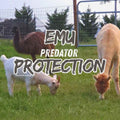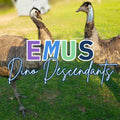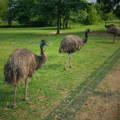
The Power Beneath: Anatomy of Emu Feet and Legs
Explore the powerful anatomy of emu feet and legs, including their role in high-speed retreats and powerful defensive kicks. Learn how these flightless birds survive using strength, speed, and specialized adaptations.
Because flight is not an option- strong, straight and powerful legs paired with large healthy feet are critical to the emus survival and defense
Subscribe
To join our mailing list and never miss an update!
Emus, the second-largest birds in the world by height, are known not only for their towering stature and shaggy plumage but also for their extraordinary legs. These long, muscular limbs are more than just a means of locomotion, they are key to the emu’s survival strategy. From rapid retreats to powerful kicks, the legs and feet of the emu are biomechanical marvels adapted for both flightlessness and self-preservation.
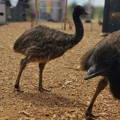
Skeletal Structure: Built for Speed and Strength
An emu's legs are composed primarily of the femur, tibiotarsus, and tarsometatarsus, which are the major long bones in the limb. These bones are densely built and highly adapted for supporting the emu’s body weight, up to 100 pounds in some adults, and for high-speed terrestrial movement.
Unlike many other birds, emus have a digitigrade posture, meaning they walk on their toes rather than the entire foot. This anatomical trait, combined with long tendons and powerful leg muscles, increases stride length and contributes to their ability to reach speeds of up to 30 miles per hour (50 km/h).
The orientation and spacing of the joints also enable quick directional changes, giving the emu an excellent ability to flee from predators across open terrain.
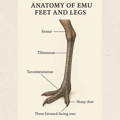
Trending Articles
Musculature: The Engine Behind the Motion
Much of the emu’s leg mass is muscle, especially in the thigh (femoral region) and lower leg. These muscle groups generate the explosive power needed for their incredibly fast sprints and sustained endurance running.
The gastrocnemius and other flexor muscles in the lower leg play a crucial role in propelling the bird forward, while specialized ligaments help conserve energy during repetitive strides.
Emus also possess long tendons that act like springs, storing and releasing kinetic energy with each step. This spring-loaded anatomy not only enhances running efficiency but also minimizes fatigue during extended periods of movement, which is critical for traversing the vast landscapes of Australia where they naturally range.
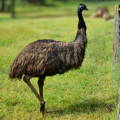
Emu Feet: A Unique Defensive Asset
Emu feet are as impressive as their legs. Each foot has three forward-facing toes, a feature that sets them apart from ostriches, which only have two. This tridactyl configuration offers a wide base for support and balance during high-speed locomotion.
What’s more, the central toe is particularly strong and each toe bears a sharp claw that can exceed 6 inches in length. While emus are generally shy and avoid confrontation, they are fully capable of defensive kicking when cornered. They deliver powerful, downward or forward kicks using one or both legs, with enough force to injure or even disembowel a predator.
This kicking ability is not just raw power, it’s precision-driven. An emu typically lifts one leg while balancing on the other and thrusts forward with remarkable control. The claws add an extra level of danger, making the emu’s feet one of its most effective tools for close-range self-defense.
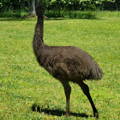
Adaptations for Survival
The evolution of the emu’s lower limbs reflects a finely-tuned balance between retreat and defense. Because arial escape is not an option for flightless birds, emus depend on their ability to outpace threats. Their legs are adapted for rapid retreats over long distances, allowing them to flee from danger quickly and efficiently.
But if escape isn't possible, their muscular legs and sharp-clawed feet provide a formidable last line of defense. This combination of flightlessness, speed, and combat capability is rare in birds, highlighting the emu's unique evolutionary niche.
In their native Australia, emus must contend with threats ranging from dingoes to humans. The ability to detect danger at a distance, thanks in part to their excellent vision and height, is complemented by their physical readiness to either flee or fight. Their powerful lower limbs are central to both strategies.
Additional Functional Features
• Shock Absorption: Their joints and tendons are structured to reduce impact, allowing them to run on hard or uneven terrain without injury.
• Nail Maintenance: Emus often scratch at the ground, using their feet not only for locomotion and defense but also for foraging and grooming behaviors.
• Balance and Posture: The emu’s center of gravity is optimized through leg positioning, giving it surprising agility despite its size.
The anatomy of the emu's feet and legs reveals a bird uniquely equipped for terrestrial life. More than just limbs, these structures are multi-functional survival tools capable of delivering speed for retreat and power for defense.
Whether sprinting across the outback or warding off a threat with a vicious kick, an emu’s legs are central to its strategy for survival. Understanding this anatomy offers insight into how evolution has shaped one of nature’s most fascinating and resilient flightless birds.
Trending Products
Copyright©2025 All rights reserved. We love to have you share our article as long as you include a direct link to this page. This article or any portion thereof , including all images, may not be reproduced or used in any manner whatsoever without the express written permission of Gypsy Shoals Farm.


